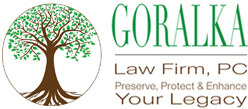Rules on Deducting Business Start-Up Expenses![Sacramento Business Lawyer Goralka]()
By, John M. Goralka
Sacramento, CA
A recent U.S. Tax Court decision drives home the important point that current deductions aren't allowed for most expenses incurred while a new business is still in the start-up phase. Other decisions have dealt with the same issue in recent years. So, the proper federal income tax treatment of start-up expenses remains an ongoing source of confusion for taxpayers.
Here's what you need to know about deducting start-up costs, along with a real-life example of how the Tax Court applied the rules.
Deduct Section 162 Expenses Now
Internal Revenue Code Section 162 allows current deductions for "ordinary and necessary" business expenses. Section 162 expenses are basically routine expenses incurred in operating an up-and-running business. Examples include employee wages, rent, utilities and advertising. Section 162 expenses can generally be deducted in the year when they're paid or incurred.
Many taxpayers are unaware that Section 162-type expenses incurred by a start-up can't necessarily be deducted right away. That's because these expenses are classified as Section 195 start-up expenses until the "active conduct" of business begins.
Once a taxpayer meets the active-conduct standard, Section 162-type expenses become Section 162 expenses, and the taxpayer can deduct them currently. (This assumes that other provisions — such as the passive activity loss or at-risk basis rules — don't come into play and prevent current deductibility.)
Deduct or Amortize Section 195 Expenses When Business Commences
Section 195 start-up expenses are Section 162-type expenses that are incurred before the business actively commences operations. Start-up expenses can include costs incurred:
- To investigate the creation or acquisition of a business,
- To create a new business, or
- To engage in any for-profit activity before the active conduct of business begins, in anticipation of such an activity becoming an active business.
Common examples of Section 195 start-up expenses include employee training, rent, utilities and marketing expenses incurred prior to opening a business.
In the tax year when active conduct of business commences, the Section 195 rules allow taxpayers to elect to amortize start-up expenses. The election potentially allows an immediate deduction for up to $5,000 of start-up expenses. However, the $5,000 deduction allowance is reduced dollar-for-dollar by the amount of cumulative start-up expenses in excess of $50,000. Any start-up expenses that can't be deducted in the tax year the election is made are amortized over 180 months on a straight-line basis. Amortization starts in the month in which the active conduct of business begins.
A taxpayer is deemed to have made this election in the tax year when active conduct of business commences unless, on a timely filed tax return for the year, the taxpayer elects instead to capitalize start-up expenses.
Important Note: Section 195 start-up expenses don't include interest expense, taxes or research and development costs. Those expenses are subject to specific rules that determine the timing of the deductions. Section 195 start-up expenses also don't include corporate organizational costs or partnership or LLC organizational costs — although the tax treatment of those expenses is similar to the treatment of start-up expenses.
Recent Tax Court Decision
A recent Tax Court case demonstrates potential pitfalls that taxpayers should avoid when claiming deductions for start-up expenses. In this case, the taxpayer was a civil engineer with 25 years of experience as a highway designer and construction engineer.
In 2008, while still employed in a full-time job, he decided to start his own business. He selected the name Civil Engineering Services (CES), printed business cards, designed stationery and set up a website. He also purchased a computer, a desk and other office supplies and set up an office in the basement of his home.
By mid-2008, the taxpayer's employer dramatically reduced his salary, and he decided to devote more time to developing CES. From his years of work experience, the taxpayer knew many contractors and project engineers who worked in the state. He regularly visited construction sites after his regular work to distribute business cards and speak with managers and others performing construction on local highways.
In addition to promoting his business, the taxpayer used these visits to stay abreast of developments in the highway construction engineering industry. He continued these trips throughout 2009, 2010 and 2011. In late 2010, he became unemployed and began focusing all of his attention on CES.
On his 2009 and 2010 federal income tax returns, the taxpayer claimed Schedule C business deductions totaling $46,629 and $45,618, respectively, for expenses purportedly incurred in the new business. After an audit, the IRS disallowed the deductions on the grounds that:
- They weren't properly substantiated, and
- CES hadn't yet commenced business because it didn't have any clients, wasn't hired to perform any services, didn't bid on any highway engineering jobs and earned no income.
The IRS also disallowed some itemized deductions claimed on the taxpayer's 2009 and 2010 returns. The disallowed deductions resulted in a delinquent tax bill of about $30,000. The IRS also imposed a 20% substantial understatement penalty on the additional tax due. The Tax Court upheld both the IRS deficiency and the understatement penalty (Tarighi v. Commissioner, T.C. Summary Opinion 2015-28).
Factors to Consider
The Tax Court has historically focused on these three factors to determine if a taxpayer has commenced the active conduct of a business:
- Did the taxpayer undertake the activity intending to earn a profit?
- Was the taxpayer regularly and actively involved in the activity?
- Has the activity actually commenced?
In Tarighi, the Tax Court concluded the taxpayer wasn't engaged in a business during 2009 and 2010, because CES didn't have any income or clients and didn't bid on any jobs during those years. Though the taxpayer did engage in promotional activities, he didn't intend to earn a profit in those years, because he didn't pursue contracts or bid on jobs.
Therefore, the court ruled that the IRS was correct in denying the deductions reported on the taxpayer's 2009 and 2010 returns, because they were amortizable Section 195 start-up expenses rather than currently deductible Section 162 expenses. However, if the taxpayer could properly substantiate the expenses, the opinion notes that the taxpayer could begin amortizing them in the year when his business activity started.
Finally, the court ruled that the IRS was correct in imposing the 20% substantial understatement penalty, because the taxpayer had failed to establish that there was any reasonable cause for the tax underpayment or that the taxpayer had acted in good faith.
Important Reminders about Start-Up Costs
When you incur business start-up expenses, it's important to remember two key points. First, start-up expenses can't always be deducted in the year when they are paid or incurred. Second, no deductions or amortization write-offs are allowed until the year when active conduct of your new business commences. That usually means the year when the business has all the pieces in place to begin earning revenue.
Time may be of the essence if you have start-up expenses that could be deducted in the current year. Contact your tax adviser to explain your plans. Failing to give your tax adviser a heads-up is often a recipe for unfavorable tax consequences. Call the Goralka Law Firm if you have any questions.
John Goralka is the lead attorney and founder of the Goralka Law Firm, P.C., and is an experienced Sacramento estate planning and tax planning lawyer.
For help in Sacramento with estate planning, business planning or tax planning, please contact our office.


